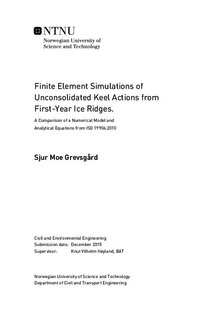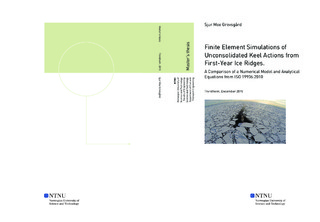| dc.description.abstract | The thesis aimed for an assessment of the current standard for determination of the keel rubble actions from a first-year ice ridge. ISO 19906:2010 (2010) gives regulations for determination of these loads, based on the work of Dolgopolov et al. (1975). The assessment involved a comparison of the ISO recommendations with the results from a numerical finite element (FE) model. Particularly the effect of the width of the structure was a target of investigation.
The FE model used the theory of a Continuum Breakage Mechanism (CBM) to describe the rubble keel s material behaviour. The material model was implemented as a user-defined subroutine (developed by Sergey A. Kulyakhtin), and the FE analyses were performed in the ABAQUS software. It was modelled as a coupled Eulerian-Lagrangian (CEL) analysis. This type of analyses are advantageous for large deformations and fluid flows etc., in accordance with the behaviour of an ice ridge. In comparison, the analytical model rests on a Mohr-Coulomb yielding criterion.
It was mainly focused on the direct comparison of the two models (the analytical and the numerical) by the predicted keel actions. This parameter compared easily, regardless of the material model in use. In other words, the comparison of the material models came indirectly through the comparison of the keel actions.
The reaction forces from the numerical model are highly dependent on the prescribed keel velocities. An increased keel velocity yielded reaction forces that approached the analytical results from Dolgopolov et al. (1975), but it also seemed to spoil the accuracy of the energy balance.
The FE model proved to give a linear fit just as the ISO standards, but it was a gentle slope compared to the analytical suggestions. For every unit length increase in structural width, the ISO predicted more than twice (approximately 2.5 times) the keel actions from the FE model. This comparison applies for the FE model with a predefined keel velocity of 2000 mm/s. In addition, the order of magnitude of the maximum forces were significantly lower than the ISO predictions. It means that the FE model and the corresponding keel actions showed a two-way effect compared to the ISO suggestions. It implied that the ISO standard suggests too high keel actions from the unconsolidated part, and the width had less to say for the total force than stated in the standards. | |

